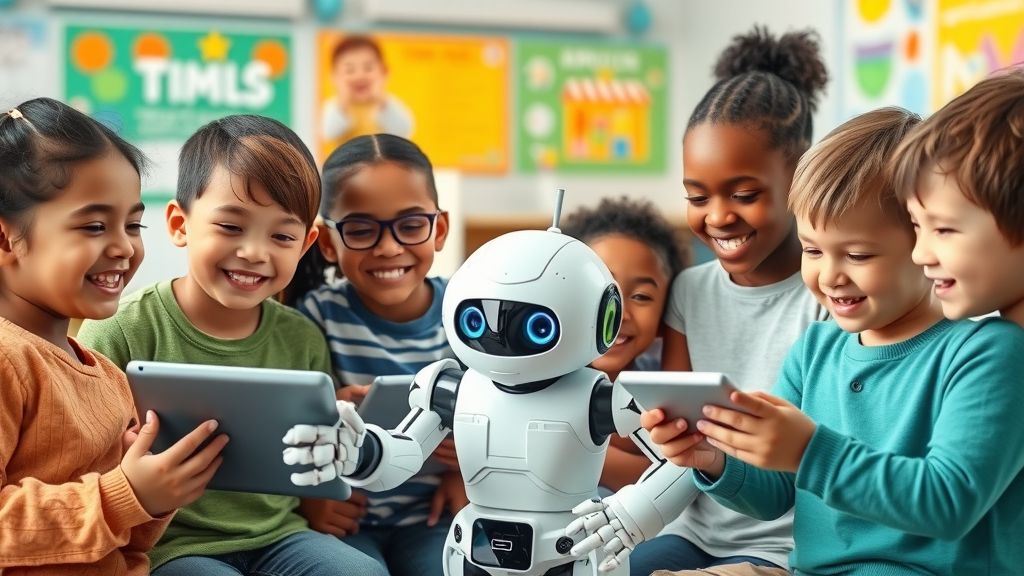"Harnessing AI for child development can be transformational, but it begins with thoughtful, guided steps."
Imagine children engaging with technology that not only entertains but nurtures their growth, sparks curiosity, and adapts to their unique learning styles. Supporting children with AI can make this a reality—when done thoughtfully. This guide demystifies how parents, teachers, and caregivers can safely and meaningfully introduce AI to kids, transform learning, and set up habits that lead to lifelong success. Ready to unlock the positive power of AI in your child's world? Dive in for proven steps, smart tips, and reassurance every step of the way.
- How supporting children with AI can improve learning outcomes
- Practical, everyday strategies for safe, healthy technology use
- Evidence-backed ways to encourage positive interactions between kids and AI
- Key considerations for parents, teachers, and caregivers
How Supporting Children With AI Empowers Growth and Curiosity
Supporting children with AI paves the way for dynamic new learning experiences. Unlike one-size-fits-all educational methods, AI tools can adapt to each child's pace and interests. This empowers kids to take ownership of their learning, follow their curiosity, and stay engaged far longer than traditional methods might allow. As children interact with AI—whether it’s an adaptive math app or a creative story generator—they build skills that stretch beyond academics, including problem-solving, digital literacy, and critical thinking.
When we introduce AI thoughtfully, we set the stage for collaborative exploration in both home and classroom settings. Simple, positive routines—like co-using technology to solve puzzles or explore interactive stories—fuel curiosity while reinforcing important values like teamwork and perseverance. Emphasizing supportive guidance rather than solo device time ensures kids benefit most from AI, developing both independence and a sense of safety as they learn.
Exploring the Positive Impacts of Supporting Children With AI
Integrating AI into daily learning offers a host of positive impacts for children. It boosts creativity by exposing kids to endless new challenges and storytelling possibilities, allowing them to explore different outcomes and spark their imagination. Critical thinking climbs as they are encouraged to question AI’s answers, investigate further, and learn new approaches by trial and error. By supporting children with AI, adults also give them the opportunity to receive instant feedback—which is a powerful motivator for mastery and perseverance.
Adaptive AI platforms shine in personalization . They respond to each child’s strengths, weaknesses, and preferences, allowing for tailored learning pathways that address diverse needs. This aspect of supporting children with AI is particularly important in mixed-ability classrooms or households, where fitting the experience to every child can be tough. The best AI tools offer hints, modify difficulty, or adjust topics to keep each learner challenged but not frustrated, ultimately enabling every child to thrive at their own pace.
Supporting children with AI also means providing equitable access to opportunities. For children with special educational needs, adaptive tools can remove barriers that traditional settings may present. Whether learning a language, practicing social skills, or addressing learning disabilities, AI resources create new pathways for support and engagement. Responsible support ensures these technologies empower rather than isolate, opening new avenues for growth and self-confidence.

- Boosting creativity and critical thinking
- Enhancing personalized learning pathways
- Addressing diverse learning needs with adaptive support
| Benefits of Supporting Children With AI | Real-World Examples | Relevant AI Tools |
|---|---|---|
| Engagement | Interactive storytelling | Chatbots, story generators |
| Personalization | Adaptive learning apps | Reading/math apps |
| Skill Building | Problem-solving games | AI-powered puzzles |
Simple Steps for Supporting Children With AI at Home and in the Classroom
Bringing AI into kids’ lives can be incredibly powerful, but it doesn’t have to be overwhelming. Start by selecting straightforward, high-quality resources that match your child's age and needs. Whether at home or in school, supporting children with AI begins with open conversations: talk about what AI is, how it works, and why it’s a tool for learning—not just entertainment.
Practically, this might look like spending a few minutes each day exploring a new app together, or rotating between hands-on activities and engaging digital lessons. Encourage kids to describe what they're learning from AI and ask questions about their discoveries. By setting up routines for device usage, previewing new apps before letting children use them independently, and modeling positive screen habits, both parents and teachers can ensure that supporting children with AI remains a healthy, collaborative experience.

Choosing Age-Appropriate AI Resources
Selecting the right AI tool is key. Begin by researching the safety, privacy settings, and educational value of any app or device your child might use. Look for platforms designed specifically for young users, which often include content moderation, robust privacy controls, and absence of invasive advertising.
Always investigate user reviews and third-party recommendations—what works for one age group may not suit another, and quality can vary widely. Test out all apps together first. By spending time with your child as they navigate a new tool, you not only assess its educational payoff but also demonstrate safe digital habits. This is a key piece in supporting children with AI—modeling healthy curiosity and review, not just blind trust.
- Research safety and privacy of AI apps
- Select tools with strong educational value
- Try apps together before independent use
Setting Boundaries: Healthy Usage Guidelines
Even the smartest technology needs boundaries. Supporting children with AI should always involve clear rules around screen time and use. Set age-appropriate limits, such as 30-60 minutes for younger children, and gradually increase independence as kids mature and demonstrate responsibility.
Successful boundaries focus not only on time, but on the quality and diversity of activities. Mix digital learning with offline play, reading, and face-to-face interactions. Discuss the importance of digital breaks, and establish device-free zones and times—like dinner or before bed. By anchoring usage in open dialogue, you’ll encourage kids to share their tech experiences, raise questions, and flag confusing or uncomfortable moments—building digital resilience and trust in the process.
- Screen time recommendations by age
- Setting digital curfews
- Encouraging open dialogue about technology
Fostering Positive Interaction: Teaching Children to Collaborate With AI
Supporting children with AI involves more than supervision—it’s about teaching kids to be active, thoughtful collaborators with technology. Guide them to ask questions, explore multiple solutions, and treat AI as a partner rather than an authority. Model how to discuss errors or unexpected answers constructively, and prompt children to seek evidence for what AI provides. By encouraging collaborative learning, adults empower kids to develop digital literacy, problem-solving skills, and the confidence to experiment safely.
Facilitate opportunities for children to create with AI, not just consume content. This can include building new stories with an AI generator, devising original games, or exploring art apps that let them design digital masterpieces. The more interactive and participatory the engagement, the more children develop agency, curiosity, and creative thinking alongside technical skills. Supporting children with AI in this way ensures technology is a means to an end—growth, discovery, and joy.

Developing Critical Thinking When Supporting Children With AI
As AI becomes a bigger part of children’s lives, teaching critical thinking is essential. Show kids that while AI is powerful, it can sometimes make mistakes or show bias. Always ask: “Do you agree? How do you know this is true?” Encourage children to cross-check facts, seek second opinions, and reflect before accepting answers at face value.
Responsible AI support also means illustrating ethical usage. Demonstrate how to credit others’ work, respect privacy, and recognize when technology should be turned off in favor of real-world interactions. By using stories and real-life examples, parents and educators can cultivate a responsible, ethical digital mindset that’s as important as technical ability.
- Teach children to question and verify information from AI
- Promote responsible use with ethical examples
- Encourage creation, not just consumption
Challenges and Solutions in Supporting Children With AI
Like any tool, supporting children with AI brings challenges alongside benefits. Chief among these are privacy risks, algorithmic bias, and the temptation for overreliance on devices . Proactively discussing potential pitfalls helps both children and adults develop awareness, confidence, and practical strategies for safer use.
Parents and teachers must frequently review privacy settings, understand how children’s data is collected and used, and select AI platforms that prioritize responsible data management. It’s equally important to teach children to use AI as one learning tool among many and to appreciate the value of hands-on, human experiences that technology can’t replicate.

Addressing Risks: Privacy, Bias, and Overreliance
The best way to tackle AI’s risks is open conversation. Read and discuss privacy policies with your child. Explain why certain information should remain private and how AI systems handle their data. Encourage children to speak up if they encounter anything strange or uncomfortable online.
Use AI tools that offer robust parental controls and monitoring features. Make a point of balancing screen time with offline activities, and emphasize that real-world experiences, friendships, and exploration are essential parts of a happy, healthy childhood. Supporting children with AI means helping them build resilience against misinformation, scams, and digital fatigue.
- Read and discuss privacy policies
- Choose tools with parental controls
- Diversify learning activities beyond AI
People Also Ask: Supporting Children With AI
How can AI be safely introduced to children?
Begin with supervised, age-appropriate, educational platforms that prioritize privacy and safety. Introduce AI by exploring apps together, explaining how they work, and highlighting the importance of digital boundaries. Keep communication open and encourage children to ask questions about their experiences to build digital resilience.
- Begin with supervised, age-appropriate, educational platforms
- Discuss usage openly to build digital resilience
What are the best AI tools for supporting children in their education?
Top choices include adaptive apps for math and reading, which tailor lessons to each child's abilities, and AI-powered story generators that spark imagination and support language development. Seek platforms recommended by educators and tested for privacy, engagement, and educational value.
- Adaptive learning apps for math and reading
- AI-powered story generators for creative expression
Does supporting children with AI increase screen time?
AI has the potential to increase screen time, but with clear guidance and intentional limits, it can fit into a balanced routine. Treat AI as a supplement to, not a replacement for, hands-on activities and social interaction, ensuring that kids enjoy a well-rounded mix of digital and real-world learning.
- It can, but parental guidance ensures a balanced approach
- Use AI as a supplement, not a replacement, for offline activities

Common Parent and Teacher Questions on Supporting Children With AI
- Which AI platforms support both classroom and home learning?
- How do I keep children safe while using AI?
- What role should adults play in supporting children with AI?
Many parents ask how to bridge technology use between school and home. Choose platforms designed for both settings, like adaptive learning suites with classroom and home logins. To keep children safe, always vet tools for privacy, supervise initial experiences, and establish clear guidelines. Most importantly, adults should serve as guides and mentors, modeling curiosity, asking thoughtful questions, and maintaining open communication about technology choices and challenges.
Adult involvement remains critical in supporting children with AI. By collaboratively exploring AI, regularly reviewing new apps, and providing supportive feedback, parents and teachers can ensure that technology amplifies—not detracts from—children’s growth, joy, and confidence. Remember, your engagement is the secret ingredient that turns digital tools into lasting sources of empowerment.
Summary of Key Strategies for Supporting Children With AI
- Emphasize critical thinking and healthy boundaries
- Choose carefully vetted technology and tools
- Use AI as a bridge to creativity and independent thought
Your Next Steps for Supporting Children With AI
Empower the children in your life with safe, smart, and positive AI experiences—start by exploring recommended apps and setting collaborative boundaries today.
Take action now: research age-appropriate AI tools, talk with kids about technology, and partner with educators to foster confident digital citizens. Supporting children with AI is a journey—let’s take the first step together!
 Add Row
Add Row  Add
Add 



Write A Comment